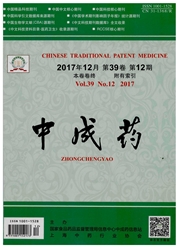

 中文摘要:
中文摘要:
目的探索Toll样受体4(TLR4)在A型流感病毒所致肺组织损伤中的影响,并进一步探讨麻杏石甘汤的干预作用。方法以A型流感病毒滴鼻感染WT型小鼠为研究对象,实验设麻杏石甘汤低、中、高剂量(1.4、2.8、5.6 g/kg)组、奥司他韦(21.63 mg/kg)组、模型组和对照组,ig给予相应药物5 d后,处理动物。常规法检测小鼠体质量,计算肺指数、脾指数、胸腺指数,观察肺组织病理变化,ELISA法检测肺泡灌洗液中炎性因子肿瘤坏死因子-α(TNF-α)、白细胞介素-1β(IL-1β)和白细胞介素-6(IL-6)的量,real-time PCR(RT-PCR)法和Western blotting法检测肺组织中TLR4、My D88、TRAF6m RNA和蛋白的表达。结果麻杏石甘汤能上调A型流感病毒感染小鼠的体质量、脾指数、胸腺指数,改善肺组织病理损伤,降低肺泡灌洗液中促炎因子水平,下调肺指数和肺组织中My D88、TRAF6 m RNA和蛋白表达量,且存在一定的量效关系。其中麻杏石甘汤中、高剂量组的疗效与奥司他韦接近。结论麻杏石甘汤作为有效的抗流感病毒中药复方,能有效地减轻肺部炎症、保护免疫器官、调节细胞因子平衡,其可能的作用机制是通过抑制TLR4-My D88-TRAF6信号通路的激活而缓解A型流感病毒感染小鼠所致的肺损伤。
 英文摘要:
英文摘要:
Objective To explore the effect of TLR4 on type A influenza virus induced lung tissue injury, and to further explore the intervention effect of Maxing Shigan Decoction(MXSGD). Methods The WT influenza virus model in mice infected with influenza A virus was established. The mice were devided into low, medium, and high dose MXSGD groups, oseltamivir group, IAV group, and Sham group. After 7 d, the treated animals were treated with corresponding clinical equivalent dose of drug. Detection in mouse body weight, lung index, spleen index, thymus index, pathological changes of lung, and ELISA method for the detection of alveolar irrigation lotion in inflammatory cytokines(TNF-α, IL-1β, and IL-6) content, real-time PCR and Western blotting detection of lung tissue TLR4, My D88, TRAF6 m RNA, and protein expression. Results MXSGD could up-regulate the weight, spleen index, and thymus index of type A influenza virus infection in WT mice, improve the pathological injury of lung tissue, decrease alveolar lavage lotion proinflammatory cytokines content, and down regulate the expression of My D88 and TRAF6 m RNA and protein in lung index and lung tissue and there is a certain dose effect relationship. The effect of high dose MXSGD group was close to oseltamivir. Conclusion MXSGD as effective anti influenza virus of traditional Chinese medicine compound can effectively reduce lung inflammation, protect immune organs, and regulate cytokine balance. The possible mechanism is alleviating the lung injury caused by type A influenza virus infection in mice through inhibition TLR4-My D88-TRAF6 signaling pathway of activation.
 同期刊论文项目
同期刊论文项目
 同项目期刊论文
同项目期刊论文
 期刊信息
期刊信息
